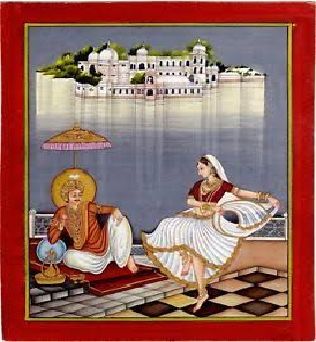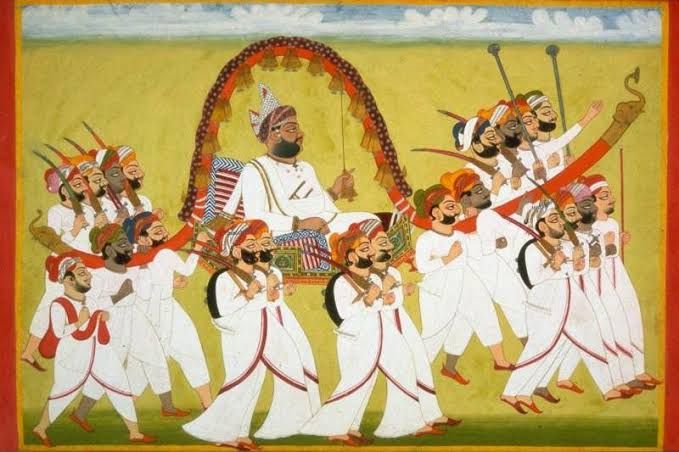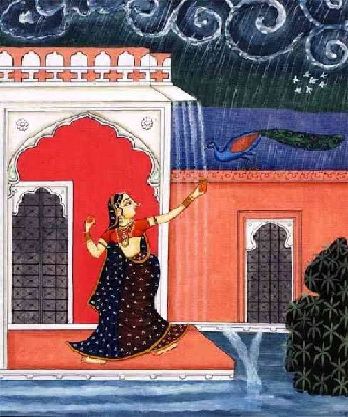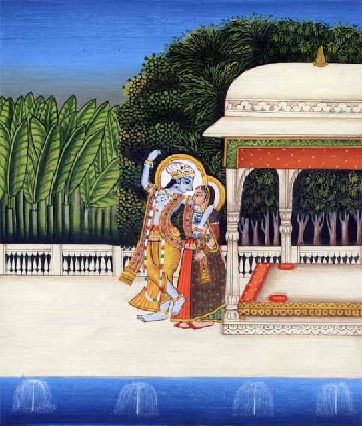Rajput Paintings
Sep 28, 2019 • 645 views
History
Closely related to the royal courts and families of Rajasthan, Rajput paintings originated in the 17th century and flourished in the 18th century in various Rajputana kingdoms. The evidence of their significance can be observed in various forts and palaces of Rajasthan such as the havelis in Shekhawati which were basically forts and palaces built under the reign of Shekhawat Rajputs. These paintings acted as representations and mode of expression for the artists of Rajasthan who replicated the society, traditions and conditions of people in their art. These paintings are the evidence of the pride and valour of the Rajput kingdoms and their rulers.

Rajput Painting - Source: Webneel
Schools of Rajput Paintings
Mewar School - The beginning of Mewar school of paintings can be said to have occurred in the start of the 17th century but due to the instability in the kingdom which occurred due to constant battles and defeats the art form suffered. After some time when the empire started to reestablish itself, this form of painting again came into light and flourished. Influenced by the political scenario of the empire these paintings in the beginning, depict bravery and vigour with the use bright, bold colors. Later as the peace of the kingdom started to regain, these paintings went back to their simplicity and poetic fluency of expression. Despite this, this form of Rajput painting saw constant ups and downs in its spread and popularity.

Mewar School of Painting- Source: Ebay
Marwar School - Originated in a small region of Marwar in south western Rajasthan, these paintings are one of the most popular art forms of India. The royal kingdoms of Bikaner, Kishangarh, Pali, Nagaur, Ghanerao and Jodhpur promoted and practiced similar kind of Rajput paintings which are together known as the Marwar school of paintings. The most prominent form of Marwar school is seen in Jodhpur paintings which are known for the use of bright yet soothing colors like yellow and blue, and men and women wearing detailed clothes with distinctive features. Other forms which are famous are Bikaner style and Kishangarh style which though belonging to the same school have their own unique features. Marwar school is much more influenced by the Mughal art than any other form.

Marwar School of Painting- Source: The Far Horizon Magazine
Hadoti School - Often known for their high quality and precision, Hadoti also known as Hadauti or Hadavati school of painting originated under the rule of Rao Chattar Shal in the mid 17th century. The regions in which this school of Rajput painting was practiced include Bundi, Baran, Jhalawar and Kota. Different styles of Hadoti paintings have their own different characteristics. The Bundi paintings which are influenced by both Deccani and Mughal art depicted feminine beauty in their own special way as well as their use of vibrant colors was another feature that made them different. The Kota style paintings are often regarded as the sub branch of Bundi style to their multiple similarities. These paintings are very realistic in their visual appeal.

Hadoti School of Painting- Source: Oh My Rajasthan
Dhundhar School - The paintings done in the regions of Amber, Jaipur, Alwar and Shekhawati are together known as Dhundhar school of paintings. From the day to day activities of rulers such as hunting and court scenes to beautiful depictions of women with perfect faces, Dhundhar school explored different phases through the paintings. These paintings establish their own uniqueness for they are neither subtle and simple like those of Bundi and Bikaner neither bold like the ones done in Marwar and Mewar schools. This form is equally influenced by both Mughal art and traditional Rajasthani art.
Materials, Tools and Special Characteristics
Rajput paintings were usually done on paper but certain evidences show their existence on the walls of palaces and forts as well. Due to the time period in which these paintings were done, the colors were mostly prepared by the painters themselves. The materials which were commonly used include chalk for white color, sienna for various shades of yellow, oxides and sulphates of green etc. With the method that was used in these paintings as well as their execution, the Rajput form of paintings were mostly made using the Persian model.
Themes and Inspiration
Rajput paintings are a strong representation of the culture and system of society of the various kingdoms of Rajasthan which had their own similarities as well as distinct characters. These paintings derived their inspiration from everything and anything that was around them. The paintings are known for their expressive nature. From the images that portrayed ambition, vigour and valour of the Rajput rulers to the lush and vibrant landscapes, all were a part of Rajput paintings making it a combination of diverging themes.
Religious and Cultural Significance
Rajput paintings despite their connection with political and social scenarios of Rajasthan, they had an equally strong relation with religion and mythological representations. These paintings very beautifully and elaborately represented scenes from the life of Krishna often called Krishna-Lila, depiction of Gods and Goddesses and stories of Bhagavad Purana. These paintings were a mirror of the beliefs and customs that were an inseparable part of the Rajasthani kingdoms and their religious traditions too can be seen in the same.

Painting Showing Krishna Lila - Source: Art of Legend India
